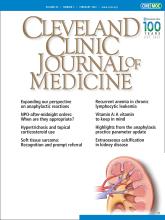Article Figures & Data
Tables
Anaphylaxis is highly likely when any 1 of the following 3 criteria is met: 1 Sudden onset of symptoms (minutes to several hours) with involvement of skin and/or mucosa (eg, generalized hives, itching or flushing, swollen lips/tongue/uvula), AND at least one of the following:
Respiratory symptoms or signs (eg, shortness of breath, wheezing, cough, hypoxemia)
Hypotension or other symptoms of target-organ dysfunction (eg, collapse, incontinence)2 Sudden onset of 2 or more of the following after exposure to a likely allergen or other trigger for that patient (minutes to several hours):
Skin or mucosal membrane symptoms
Respiratory symptoms
Hypotension or other symptoms of target-organ dysfunction
Gastrointestinal symptoms such as abdominal pain or vomiting3 Hypotension occurring acutely (minutes to several hours) after exposure to a known or established allergen for that patient. Hypotension is defined as the following:
Adults: Systolic blood pressure < 90 mm Hg, or a decrease > 30% from patient’s baseline
Infants and children: Low systolic blood pressure (age-specific) or a decrease > 30% in systolic pressureBased on information from reference 1.
Treatment of anaphylaxis Administer epinephrine as first-line pharmacotherapy for uniphasic or biphasic anaphylaxis. Do not delay the administration of epinephrine for anaphylaxis. All patients with anaphylaxis should receive education about anaphylaxis, risk of recurrence, trigger avoidance, self-injectable epinephrine, and thresholds for further care. Patients should also be referred to an allergist for follow-up evaluation. Biphasic anaphylaxis Risk factors for biphasic reactions include severe anaphylaxis or the need for more than 1 dose of epinephrine to treat anaphylaxis, wide pulse pressure, unknown anaphylaxis trigger, cutaneous signs and symptoms, and drug triggers in children. Antihistamines and glucocorticoids are not reliable interventions to prevent biphasic anaphylaxis but may be considered as second-line treatment. After treatment, all patients with anaphylaxis should be kept under observation until symptoms have fully resolved. Extended observation beyond resolution of symptoms is suggested for patients who had severe anaphylaxis or required more than 1 dose of epinephrine. Use of histamine-1 antihistamines and glucocorticoids to prevent anaphylactic reactions Premedication with antihistamine or glucocorticoid or both in specific chemotherapy protocols and specific aeroallergen immunotherapy procedures may decrease the risk of systemic reactions. Patients with a history of reactions to radiocontrast media should receive low- or iso-osmolar radiocontrast media with future procedures to reduce the risk of future reactions. Routine glucocorticoid or antihistamine premedication may not reduce the risk of hypersensitivity reactions, though they should be considered in patients perceived to be at high risk of anaphylaxis or with comorbidities that increase the anaphylaxis fatality risk. Based on information from reference 1.






